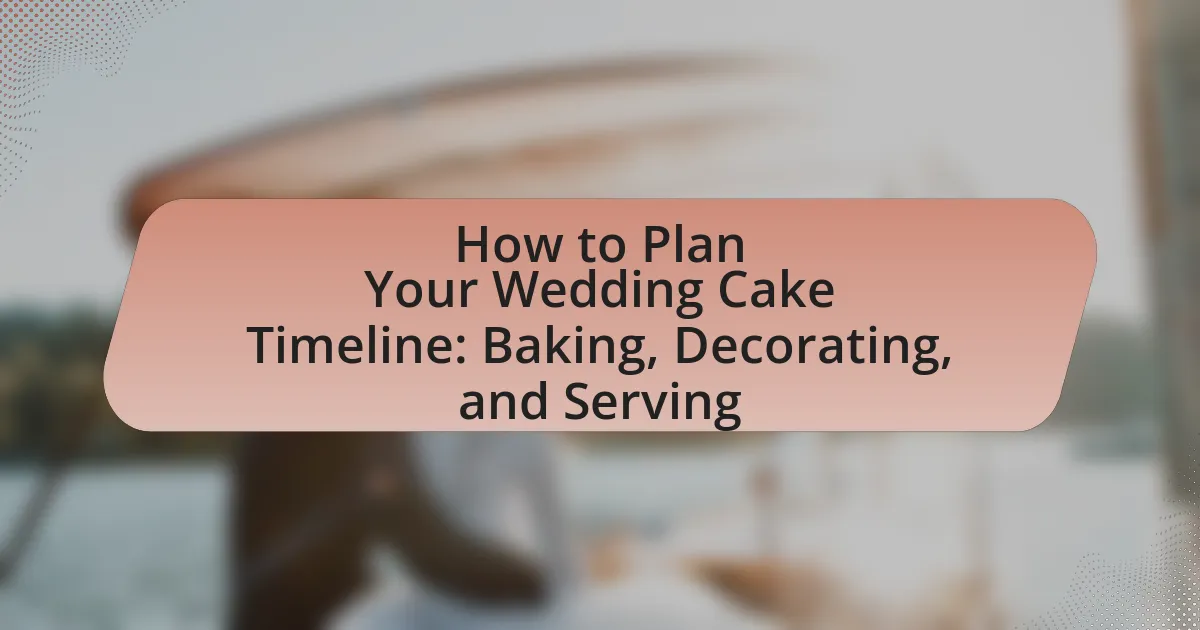The article focuses on the critical aspects of planning a wedding cake timeline, encompassing the processes of baking, decorating, and serving. It emphasizes the importance of a structured timeline to ensure the cake is prepared and served at the right moment, maintaining its quality and freshness. Key milestones include selecting a cake design, booking a baker, and scheduling delivery, while best practices for decorating and serving are also outlined. Additionally, the article addresses common challenges in wedding cake planning and offers troubleshooting tips to ensure a smooth experience for couples and their guests.
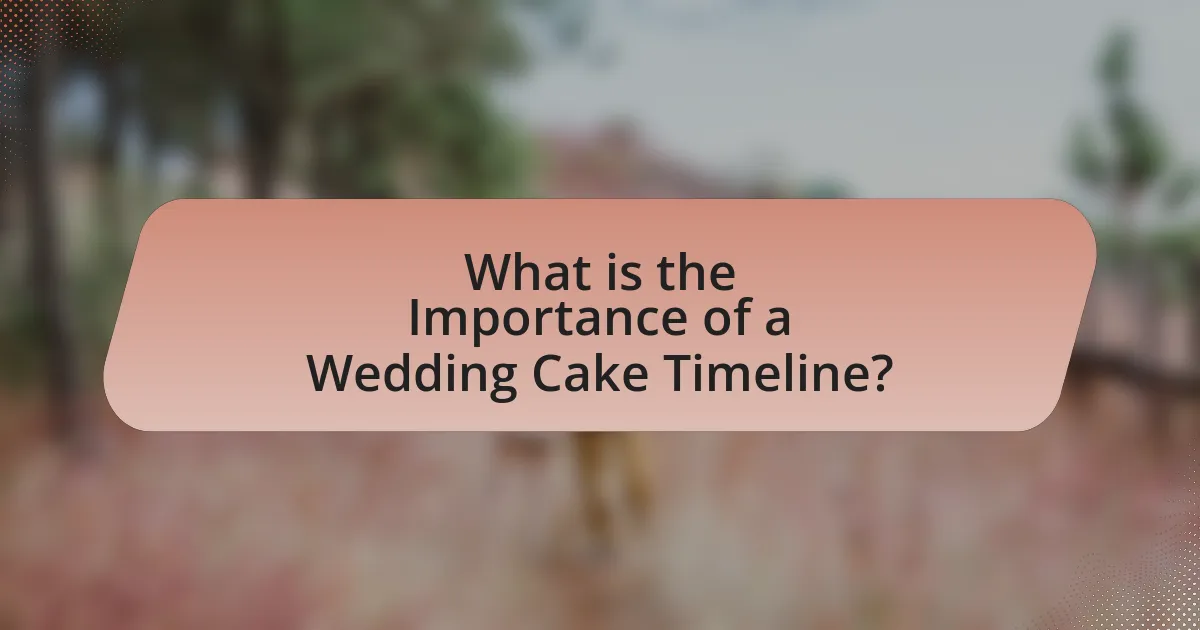
What is the Importance of a Wedding Cake Timeline?
A wedding cake timeline is crucial for ensuring that the cake is baked, decorated, and served at the optimal time during the wedding festivities. This timeline helps coordinate the various stages of cake preparation, allowing for proper cooling, decoration, and transportation, which are essential for maintaining the cake’s quality and appearance. For instance, cakes typically require several hours to cool before they can be decorated, and a well-structured timeline ensures that these processes do not overlap with other wedding activities, preventing last-minute stress. Additionally, a timeline aids in scheduling the cake cutting, which is a significant moment during the reception, ensuring that it aligns with other events like speeches or toasts.
How does a wedding cake timeline impact the overall wedding planning process?
A wedding cake timeline significantly impacts the overall wedding planning process by establishing key deadlines for baking, decorating, and delivery. This timeline ensures that the cake is prepared in alignment with other wedding elements, such as venue setup and catering schedules. For instance, a well-structured timeline allows bakers to allocate sufficient time for each stage, from initial design consultations to final assembly, which is crucial for maintaining quality and freshness. Additionally, adhering to a timeline helps avoid last-minute stress and potential issues, such as scheduling conflicts with other vendors. By coordinating the cake timeline with the overall wedding schedule, couples can ensure a seamless integration of the cake into their celebration, enhancing the overall experience for themselves and their guests.
What are the key milestones in a wedding cake timeline?
The key milestones in a wedding cake timeline include selecting a cake design, booking a baker, tasting cake samples, finalizing the cake order, scheduling the delivery, and cutting the cake at the reception. Selecting a cake design typically occurs several months before the wedding, allowing couples to choose flavors and styles that reflect their theme. Booking a baker should follow shortly after, ideally three to six months in advance, to ensure availability. Cake tastings usually happen after the initial booking, where couples can sample different flavors and finalize their choices. Finalizing the cake order, including size and decoration details, should occur about one month before the wedding. Scheduling delivery is crucial to ensure the cake arrives fresh and on time, typically arranged a few days prior to the event. Finally, the cake cutting is a significant moment during the reception, symbolizing the couple’s first act together as a married couple.
How can a well-planned timeline reduce stress for the couple?
A well-planned timeline can significantly reduce stress for the couple by providing a clear structure for tasks and deadlines. This structured approach allows couples to allocate time effectively for each aspect of their wedding cake preparation, including baking, decorating, and serving. By having a detailed timeline, couples can avoid last-minute rushes and ensure that each task is completed in a timely manner, which minimizes anxiety and uncertainty. Research indicates that effective time management can lead to lower stress levels, as it helps individuals feel more in control of their responsibilities and reduces the likelihood of overlooking important details.
Why is it essential to coordinate baking, decorating, and serving?
Coordinating baking, decorating, and serving is essential to ensure the wedding cake maintains its quality and aesthetic appeal. Proper timing in baking allows the cake to cool adequately before decorating, preventing structural issues and ensuring the frosting adheres properly. Additionally, synchronizing these processes ensures that the cake is served fresh, enhancing the overall guest experience. Research indicates that cakes served at optimal freshness significantly improve taste perception, which is crucial for memorable events like weddings.
What are the consequences of poor coordination in cake preparation?
Poor coordination in cake preparation can lead to several negative outcomes, including inconsistent texture, uneven baking, and compromised flavor. When ingredients are not measured accurately or added in the wrong order, the chemical reactions necessary for proper cake structure may be disrupted, resulting in a dense or dry cake. Additionally, poor timing in the baking process can cause cakes to overbake or underbake, affecting their overall quality. For instance, a study published in the Journal of Culinary Science & Technology highlights that precise ingredient ratios and timing are critical for achieving the desired cake characteristics. Therefore, lack of coordination can ultimately result in a cake that fails to meet expectations, impacting the overall success of an event like a wedding.
How does timing affect the freshness and quality of the cake?
Timing significantly affects the freshness and quality of a cake by determining how long it remains moist and flavorful. Cakes are best consumed within a few days of baking, as exposure to air can lead to staleness and loss of texture. For instance, a cake baked too far in advance may dry out, while one that is decorated and served promptly retains its intended taste and moisture. Additionally, the timing of refrigeration can impact the cake’s quality; refrigerating a cake too early can cause it to dry out, while waiting too long can lead to spoilage. Therefore, adhering to a precise timeline for baking, decorating, and serving is crucial to ensure optimal freshness and quality.
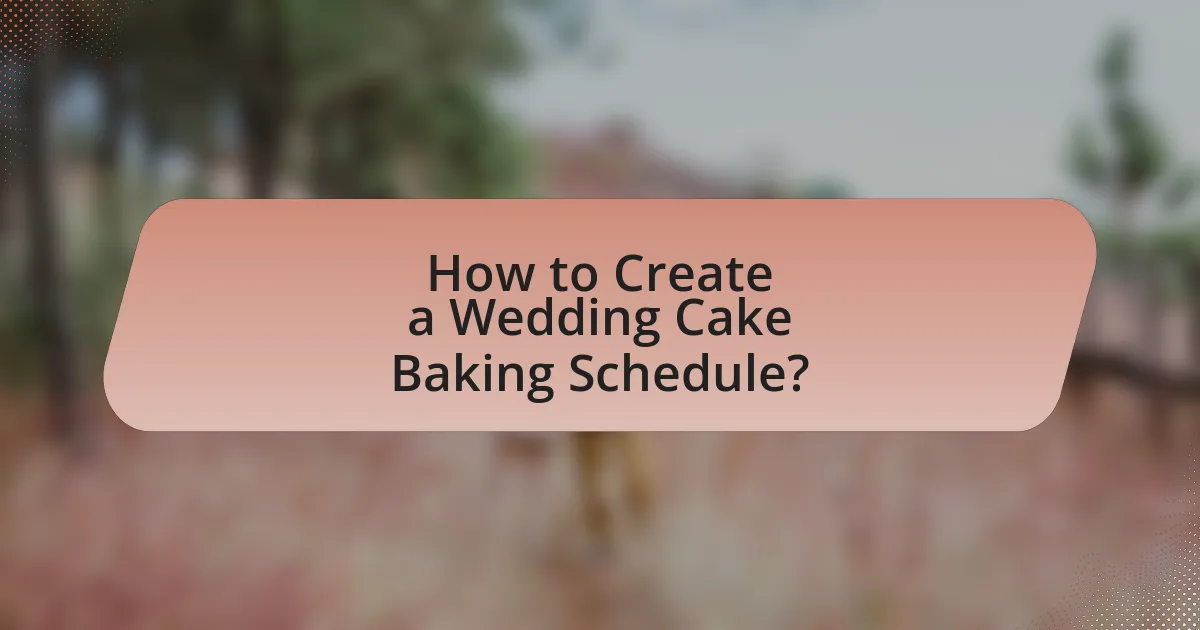
How to Create a Wedding Cake Baking Schedule?
To create a wedding cake baking schedule, first determine the date of the wedding and work backward to establish a timeline. Begin by allocating time for each cake layer to bake, cool, and be decorated, typically allowing at least three days before the wedding for baking and decorating. For example, if the wedding is on a Saturday, plan to bake the cake on Wednesday, allowing Thursday for cooling and Friday for decorating. This schedule ensures that the cake is fresh and allows time for any adjustments. Additionally, consider the complexity of the cake design, as intricate decorations may require more time.
What factors should be considered when planning the baking schedule?
When planning the baking schedule for a wedding cake, key factors include the type of cake, baking time, cooling time, and decoration requirements. The type of cake influences the baking duration; for instance, dense cakes like fruitcake require longer baking times compared to lighter cakes. Cooling time is essential, as cakes must be completely cooled before frosting, which can take several hours. Additionally, the complexity of decorations affects the schedule; intricate designs may require more time for preparation and application. Properly accounting for these factors ensures that the cake is baked, cooled, and decorated in a timely manner, leading to a successful presentation on the wedding day.
How does the type of cake influence the baking timeline?
The type of cake significantly influences the baking timeline due to variations in ingredients, density, and moisture content. For instance, lighter cakes like sponge or chiffon require shorter baking times, typically around 25 to 30 minutes, because they contain more air and less fat. In contrast, denser cakes such as fruitcake or pound cake take longer to bake, often ranging from 50 to 90 minutes, as their composition retains moisture and requires more time to cook through evenly. This difference in baking duration is essential for achieving the desired texture and doneness, ensuring that each cake type is properly baked without being undercooked or overbaked.
What are the recommended baking times for different cake types?
The recommended baking times for different cake types vary significantly. For example, a standard round cake typically bakes for 25 to 35 minutes at 350°F (175°C), while a pound cake requires 60 to 70 minutes at the same temperature. A sponge cake generally needs 20 to 30 minutes, and a cheesecake usually takes about 50 to 60 minutes. These times are based on common baking practices and can vary depending on oven calibration and specific recipes.
How can you ensure the cake is baked in time for decorating?
To ensure the cake is baked in time for decorating, start by creating a detailed timeline that includes all baking and cooling times. For example, if a cake requires a baking time of 30 minutes and needs to cool for at least 2 hours before decorating, plan to start baking at least 2.5 hours before you intend to decorate. This allows for any unforeseen delays. Additionally, using a reliable recipe with accurate baking times can help ensure consistency. According to baking experts, cakes should be completely cooled to room temperature to prevent melting frosting, which reinforces the importance of timing in the baking process.
What is the ideal cooling time before decorating a cake?
The ideal cooling time before decorating a cake is typically 2 to 3 hours. This duration allows the cake to cool completely to room temperature, which is essential to prevent melting or sliding of the frosting and decorations. Cakes that are still warm can cause the icing to melt, leading to an undesirable appearance and texture. Therefore, ensuring a thorough cooling period is crucial for achieving a well-decorated cake.
How can you manage multiple layers or tiers in the baking process?
To manage multiple layers or tiers in the baking process, ensure each layer is baked separately and cooled completely before assembly. This method prevents structural issues and allows for even baking. For example, using a consistent baking time and temperature for each layer ensures uniformity, while cooling racks facilitate proper air circulation, reducing moisture buildup. Additionally, employing dowels or supports between layers provides stability, which is crucial for multi-tiered cakes, especially those exceeding three layers. This approach is validated by professional bakers who emphasize the importance of cooling and structural integrity in tiered cake construction.
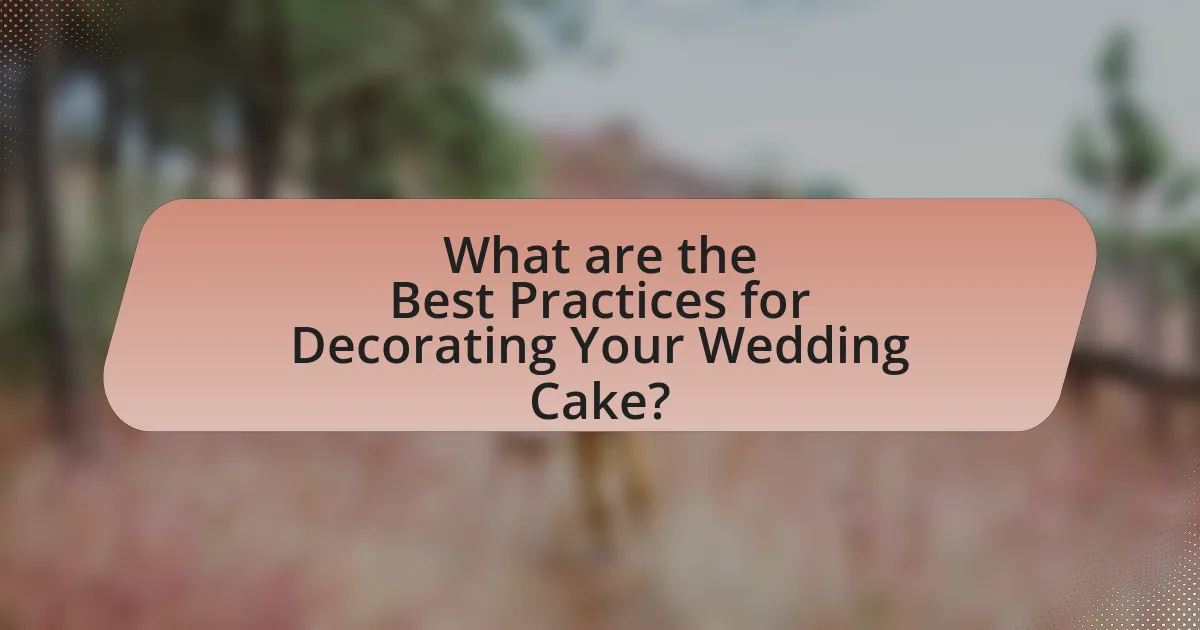
What are the Best Practices for Decorating Your Wedding Cake?
The best practices for decorating your wedding cake include planning the design in advance, using high-quality ingredients, and ensuring proper structural support. Planning the design allows for a cohesive theme that matches the wedding’s aesthetic, while high-quality ingredients enhance both flavor and appearance. Structural support, such as dowels or cake boards, is essential for multi-tiered cakes to prevent collapsing. Additionally, practicing techniques like piping and fondant application can improve the final look, as evidenced by professional bakers who emphasize preparation and skill development in their decorating processes.
How can you plan the decorating timeline effectively?
To plan the decorating timeline effectively, start by establishing a clear schedule that outlines each step of the decorating process. This includes determining when to bake the cake, allowing it to cool, and setting aside time for decorating, which should ideally occur one to two days before the event to ensure freshness. Research indicates that cakes decorated too far in advance may lose their texture and flavor, making timely execution crucial. Additionally, allocate specific time blocks for each decorating task, such as applying fondant, piping decorations, and adding finishing touches, to maintain organization and efficiency.
What are the essential steps in the cake decorating process?
The essential steps in the cake decorating process include preparing the cake, applying a crumb coat, adding the final layer of frosting, and decorating with additional elements. First, the cake must be cooled and leveled to ensure a stable base. Next, a crumb coat, which is a thin layer of frosting, is applied to seal in crumbs and create a smooth surface. After chilling the cake, a thicker layer of frosting is added for the final finish. Finally, decorations such as fondant, edible flowers, or piping are applied to enhance the cake’s appearance. These steps are crucial for achieving a professional-looking cake that is visually appealing and ready for serving.
How long should each decorating step take?
Each decorating step for a wedding cake should take approximately 30 minutes to 2 hours, depending on the complexity of the design. For instance, simple tasks like applying a base coat of frosting may take around 30 minutes, while intricate designs involving fondant or detailed piping can require up to 2 hours. This timeframe is supported by industry standards, where professional bakers often allocate specific durations for various decorating techniques to ensure quality and precision in the final product.
What techniques can enhance the decoration of your wedding cake?
Techniques that can enhance the decoration of your wedding cake include the use of fondant, edible flowers, and intricate piping. Fondant provides a smooth, polished finish that can be molded into various shapes and designs, allowing for a professional appearance. Edible flowers add a natural and elegant touch, while intricate piping techniques can create detailed patterns and textures, enhancing the visual appeal. These methods are widely used in the cake decorating industry, as they not only improve aesthetics but also allow for personalization, making each cake unique to the couple’s style and theme.
How do different decorating styles affect the timeline?
Different decorating styles significantly affect the timeline of wedding cake preparation and execution. For instance, intricate styles like fondant or sugar flowers require more time for both preparation and application, often extending the decorating phase by several hours or even days. In contrast, simpler styles, such as buttercream or naked cakes, can be completed more quickly, allowing for a more streamlined timeline.
Research indicates that cakes with elaborate designs can take up to 50% longer to decorate compared to those with minimal embellishments, impacting the overall schedule for baking and serving. Therefore, the choice of decorating style directly influences the time allocated for each phase of the wedding cake process, necessitating careful planning to ensure timely completion.
What tools and materials are necessary for effective cake decoration?
Effective cake decoration requires essential tools and materials such as a turntable, offset spatula, piping bags, and various decorating tips. A turntable allows for smooth rotation while decorating, ensuring even application of frosting. An offset spatula is crucial for spreading icing and creating smooth finishes. Piping bags, along with different tips, enable intricate designs and details, enhancing the cake’s visual appeal. Additionally, fondant, food coloring, and edible decorations like sprinkles or flowers are important materials that contribute to the overall design and aesthetic of the cake. These tools and materials are widely recognized in the baking community for their effectiveness in achieving professional-looking cake decorations.
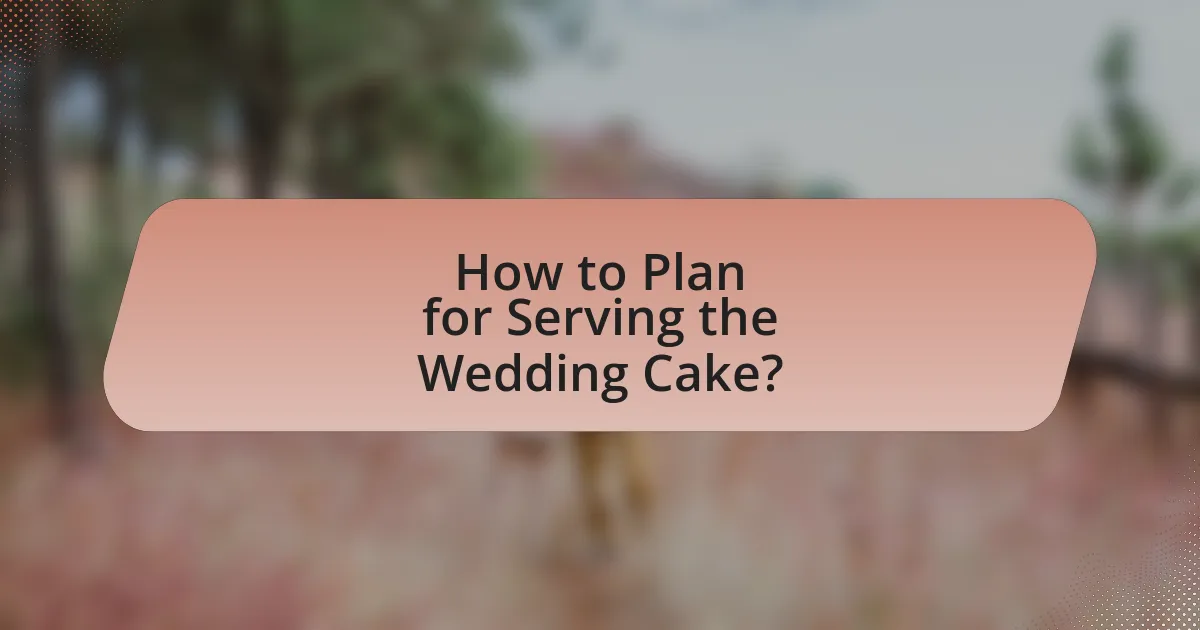
How to Plan for Serving the Wedding Cake?
To plan for serving the wedding cake, first determine the number of guests to ensure adequate portions, typically one slice per guest. Next, select a serving style, such as plated service or buffet, which influences how the cake is cut and presented. Additionally, coordinate with the venue staff or caterers to establish a timeline for when the cake will be served, ideally after the meal and before dancing begins, to maintain the flow of the event. It is also essential to consider the cake’s storage and display, ensuring it remains fresh and visually appealing until serving time. Proper planning ensures a seamless experience for both the couple and their guests.
What considerations should be made for serving logistics?
Considerations for serving logistics include the timing of cake delivery, the temperature control during transport, and the setup requirements at the venue. Proper timing ensures that the cake is fresh and ready for serving, typically requiring delivery shortly before the event begins. Temperature control is crucial, as cakes can be sensitive to heat and humidity, potentially affecting their appearance and taste; for example, buttercream cakes should be kept cool to maintain their structure. Additionally, setup requirements involve ensuring that the serving area is prepared with necessary tools, such as cake stands and serving utensils, to facilitate a smooth serving process. These factors collectively contribute to the successful presentation and enjoyment of the wedding cake.
How can you determine the right serving size for guests?
To determine the right serving size for guests, calculate the total number of guests and divide it by the number of servings a cake tier provides. For example, a standard wedding cake tier typically serves 12 to 15 people, so if you have 100 guests, you would need approximately 7 to 8 tiers to ensure everyone is served. This calculation is based on the average serving size of 1 inch by 2 inches for a wedding cake slice, which is a widely accepted standard in the catering industry.
What are the best practices for cutting and serving the cake?
The best practices for cutting and serving a cake include using a sharp, serrated knife to ensure clean slices and cutting the cake in a systematic manner, typically starting from the top tier and moving downwards. This method helps maintain the cake’s structure and makes it easier to serve. Additionally, it is recommended to cut the cake into even portions, approximately 1 to 2 inches wide, to ensure that all guests receive a fair share.
For serving, it is ideal to use a cake server or spatula to lift the slices onto plates, minimizing mess and maintaining presentation. Serving the cake at room temperature enhances flavor and texture, as cold cake can be dense and less enjoyable. These practices are supported by culinary experts who emphasize the importance of presentation and portion control in cake serving.
How can you ensure the cake remains fresh until serving?
To ensure the cake remains fresh until serving, store it in an airtight container or wrap it tightly in plastic wrap. This method prevents air exposure, which can lead to drying out or staleness. Additionally, keeping the cake in a cool, dry place away from direct sunlight helps maintain its moisture and flavor. Cakes can also be refrigerated if necessary, but it is essential to allow them to come to room temperature before serving to enhance taste and texture.
What storage methods are recommended before the wedding?
The recommended storage methods before the wedding include refrigeration for perishable items and room temperature storage for non-perishable components. Refrigeration helps maintain the freshness of ingredients like buttercream and fillings, which can spoil if left out. Non-perishable items, such as fondant decorations, should be stored in a cool, dry place to prevent melting or damage. Proper storage ensures that all components of the wedding cake remain in optimal condition until the event.
How does temperature affect the cake’s quality during serving?
Temperature significantly affects a cake’s quality during serving by influencing its texture, flavor, and overall presentation. When served at an optimal temperature, typically around room temperature, cakes maintain a moist texture and enhanced flavor profile, allowing the ingredients to be fully appreciated. Conversely, serving a cake too cold can result in a dense texture and muted flavors, while serving it too warm may cause structural issues, such as melting frosting or collapsing layers. Research indicates that cakes served at room temperature provide the best sensory experience, as flavors are more pronounced and the cake’s moisture is preserved, leading to higher satisfaction among guests.
What are some common challenges in wedding cake planning and how to overcome them?
Common challenges in wedding cake planning include selecting the right flavor, managing dietary restrictions, coordinating delivery and setup, and ensuring the cake design aligns with the wedding theme. To overcome flavor selection issues, couples should conduct tastings with multiple bakers to find a preferred option. Addressing dietary restrictions requires clear communication with the baker about allergies or preferences, allowing for customized solutions. To manage delivery and setup, couples should establish a timeline with the baker and venue to ensure timely arrival and proper placement. Finally, to ensure the cake design matches the wedding theme, couples should provide the baker with inspiration images and detailed descriptions, facilitating a cohesive final product.
How can you troubleshoot issues that arise during baking or decorating?
To troubleshoot issues that arise during baking or decorating, first identify the specific problem, such as uneven baking, frosting consistency, or decoration adherence. For uneven baking, ensure the oven temperature is accurate by using an oven thermometer, as a study by the American Society of Baking indicates that temperature discrepancies can lead to inconsistent results. For frosting consistency, adjust the ratio of powdered sugar to liquid; too much liquid can cause runniness, while too much sugar can lead to a dry texture. If decorations are not adhering, check that the surface is properly cooled and use a thin layer of frosting as a glue. These methods provide effective solutions to common baking and decorating challenges.
What tips can help ensure a smooth cake serving experience?
To ensure a smooth cake serving experience, it is essential to prepare the cake properly and organize the serving process efficiently. First, allow the cake to cool completely before cutting, as this prevents crumbling and ensures clean slices. Additionally, use a sharp, serrated knife for cutting, which helps achieve even portions. It is also beneficial to have a designated area for serving, equipped with plates, utensils, and napkins, to streamline the process. Furthermore, consider pre-slicing the cake if it is large, as this can expedite serving and reduce wait times for guests. These practices are supported by catering professionals who emphasize the importance of preparation and organization in successful cake serving.
